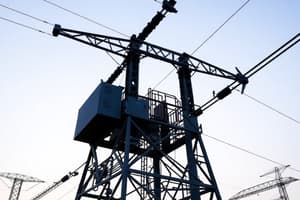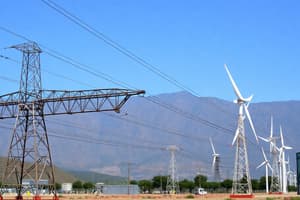Podcast
Questions and Answers
What is electricity a form of?
What is electricity a form of?
- Energy (correct)
- Matter
- Liquid
- Gas
How is electricity usually generated?
How is electricity usually generated?
- By cooking food
- By fishing
- By burning fossil fuels (correct)
- By planting trees
At what voltages are electricity typically transmitted?
At what voltages are electricity typically transmitted?
- 500 kV - 1000 kV
- 200 kV - 500 kV (correct)
- 50 kV - 100 kV
- 10 kV - 50 kV
What is the most common method of converting mechanical energy into electrical energy?
What is the most common method of converting mechanical energy into electrical energy?
What part of a generator converts mechanical energy into electrical energy?
What part of a generator converts mechanical energy into electrical energy?
Which application below is NOT mentioned in the text as a use of electricity?
Which application below is NOT mentioned in the text as a use of electricity?
What is one of the sustainable forms of electricity generation mentioned in the text?
What is one of the sustainable forms of electricity generation mentioned in the text?
How do wind turbines generate electricity?
How do wind turbines generate electricity?
What is the role of hydroelectric energy in electricity generation?
What is the role of hydroelectric energy in electricity generation?
What is not a sustainable form of electricity generation?
What is not a sustainable form of electricity generation?
Which of the following is NOT mentioned as an application of electricity in the text?
Which of the following is NOT mentioned as an application of electricity in the text?
What is the importance of sustainable forms of electricity generation?
What is the importance of sustainable forms of electricity generation?
Flashcards are hidden until you start studying
Study Notes
Electricity
Electricity is a form of energy resulting from the existence of charged particles such as electrons or ions, either statically accumulated on objects or moving through conductive media. It can be generated by various means, including burning fossil fuels, nuclear fission, hydroelectric power plants, wind turbines, solar panels, and geothermal energy. This energy can then be transmitted over long distances without significant loss via high voltage transmission lines.
The generation of electricity usually involves converting mechanical energy into electrical energy. The most common method is through the use of a turbine, which is turned by steam, water, wind, or other forms of motion. This causes the turbine to spin rapidly, which generates a magnetic field. The moving parts in the generator are then capable of converting this mechanical energy into electrical energy.
Transmission and Distribution
Electricity is transmitted over long distances to reach power plants and then distributed to homes and businesses. The transmission lines are typically high voltage, with voltages ranging from 115 kV to 765 kV. The electricity is then distributed at lower voltages, usually between 11 kV and 34.5 kV.
Uses of Electricity
Electricity is used in a wide variety of applications, including:
- Lighting: Electricity is used to power light bulbs, providing illumination for homes and businesses.
- Heating: Electricity can be used to heat homes and buildings, either through central heating systems or individual electric heaters.
- Appliances: Many household appliances, such as refrigerators, ovens, and air conditioners, require electricity to operate.
- Entertainment: Electricity powers television, computer, and sound systems, as well as other forms of entertainment.
- Industry: Electricity is used in manufacturing processes, as well as powering machinery and equipment in factories and workshops.
Sustainable Electricity
As the world seeks to reduce its dependence on fossil fuels, sustainable forms of electricity generation have become increasingly important. These include:
- Solar energy: Solar panels convert sunlight into electricity, which can be used directly or stored for later use.
- Wind energy: Wind turbines convert the kinetic energy of wind into electricity, which can be used directly or stored.
- Hydroelectric energy: This form of electricity uses the kinetic energy of moving water to generate electricity.
- Geothermal energy: This form of electricity uses the heat from the earth's interior to generate electricity.
- Biomass energy: This form of electricity uses organic materials, such as wood or agricultural waste, to generate electricity.
In conclusion, electricity is a vital form of energy that powers our modern world. It is generated through various means, transmitted over long distances, and used in a wide variety of applications. As we seek to reduce our dependence on fossil fuels, sustainable forms of electricity generation are becoming increasingly important.
Studying That Suits You
Use AI to generate personalized quizzes and flashcards to suit your learning preferences.



